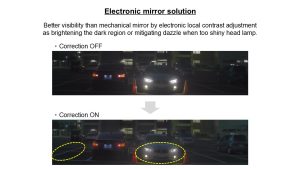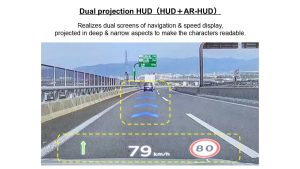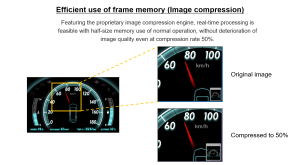Feed aggregator
Nuvoton Releases 4th Generation of “Gerda,” the Automotive HMI Display IC Series in 3 Variants
Nuvoton Technology Corporation Japan (NTCJ) will start a series production of automotive
HMI display IC “Gerda”, 4th generation, which are 3 types (Gerda-4M/ Gerda-4L/ Gerda-4C).
This lineup features image processing technology, security, and display safety functions for the various HMI devices which are progressing under expectation to support the higher level of safety requirement. And it contributes to realizing the HMI solutions which enhance vehicle safety and comfort.
Achievements:
- By producing the high visibility of interior display utilities such as electronic mirrors, AR-HUD, and cluster meters, “Gerda” assists comfort and fatigue-resistant safe driving by system.
- By high-speed and large capacity memory built in “Gerda” allows customers to develop the high-functional HMI systems with advanced display capability without external memory at reasonable cost in system.
- “Gerda” features OTA (Over-The-Air software updating) and secure boot functions, and contributes to the safe and comfort systems by mitigating the risks of on-vehicle cyber security and supporting the functional safety level ASIL-B.
Features:
- Refined visibility and comfort of HMI equipment is realized with unique image processing engine.
Our video processing technology is ideal for electronic mirrors, AR-HUDs, and cluster meters, which are becoming widely spread due to digitization of equipment installed in cars, to create a safe and comfortable driving environment.
– Features for electronic mirrors
The issue with conventional e-mirrors had issues with reduced visibility, especially in night time camera images, due to glare caused by headlight light and white blown out/blacked out due to big gap in brightness.
With Gerda-4M, it is possible to improve the visibility by adjusting the picture contrast locally, in response to the brightness distribution by area (“local contrast” function), can be achieved with low-latency processing of 1 frame.

– Features for AR-HUD
It is essential with AR-HUD that the display naturally kept shown in the driver’s eyesight by harmonizing the displayed contents to the windshield shape.
For this, displaying image needs to be projected in low latency, and flexible deformed to fit the windshield. Image warping engine allows free deformation to fit the screen at lower latency than 1 frame. And it supports “dual projection HUD” with single chip, which both 2 images are projected in near and far focuses.

– Features for cluster meters
It is essential with cluster-meter that multiple assisting information is conducted to drivers accurately and intuitively. And its design needs to flexibly match the interior. Nuvoton’s Gerda has 2.5D GFX engine which allows customers to design the screen with cubic effects like depth and shades added to the design by 2D objects. It provides the display with higher visibility and contributes to the accurate decision of drivers. And by combination with the image compression engine, displaying images at as high resolution as WXGA@60FPS which enables the higher-grade cockpit design.
- Multi-functional HMI system is realized at reduced system cost with built-in high speed/ large size memory.
In general, construction of high-performance HMI systems requires external memories the system. Nuvoton’s lineup of Gen.4 is embedded with the memory of high speed and large capacity, which makes external memory unnecessary, and contributes to reduce the component counts and system cost. And Gerda-4L has built-in the dedicated image compression engine which enables the real-time processing at half memory usage than normal use, and it realizes high resolution image display as WXGA@60FPS only with the built-in memory.

- Supporting Functional Safety ASIL-B, and contributing to the risk mitigation of vehicle cyber security
Gen.4 Gerda features the display safety functions as video signal monitoring, alert display monitoring etc., and contributes to realize the system of Functional Safety ASIL-B by supporting the functions as fail-safe, real-time monitoring. And the built-in HSM which supports EVITA-Full achieves the software update via network (OTA) and secure boot, which allows only trusted software to boot up. It helps to mitigate the risk of vehicle cyber security.
NTCJ developed the 3 types of 4th generation of HMI display IC “Gerda” series which is equipped with a wide range of image processing technologies and advanced security functions and has started its mass production.
The post Nuvoton Releases 4th Generation of “Gerda,” the Automotive HMI Display IC Series in 3 Variants appeared first on ELE Times.
WORKS Integration – the data center for intelligent manufacturing
ASMPT presents central platform for data exchange in electronics manufacturing.
“WORKS Integration ensures that all production data is available exactly where it is needed for things like production planning and setup preparation, material flow and process optimization, and quality control,” said Thomas Bliem, Vice President R&D at ASMPT SMT Solutions. “By creating a centrally networked database with high connectivity across all systems, the platform makes fully digitized and highly automated intelligent production possible.”
A central data hub for all systems
Extending across all protocols and versions, WORKS Integration establishes an IIoT communication base to which the sensors on the production hardware as well as all software applications send their data. In addition to connecting the entire hardware and software portfolio of ASMPT SMT Solutions, WORKS Integration makes it possible to integrate third-party machines and programs via industry-standard interfaces. Even complex customer-specific applications can be easily linked via proprietary interfaces.
All connected systems obtain the information they need exclusively via WORKS Integration. Operating in the background, the application enables the continuous exchange of data between different hardware and software entities irrespective of their format or manufacturer.
WORKS Integration supports proven internal machine interfaces as well as industry standards such as IPC-2591, CFX, and SECS/GEM. Adapters convert all incoming information into a shared public data structure.
Centralized, standardized, resilient
This unified system offers numerous advantages for users. Since the various instances do not communicate with each other directly but exclusively through WORKS Integration, the number of interfaces and data channels is reduced considerably, as are potential interdependencies and sources of errors.
Machines and/or programs can be easily replaced, updated and scaled up or down without creating version conflicts or redundant data streams while encrypted communication reliably protects the system from unauthorized access. In addition, a central health monitoring system provides valuable information for technical support and fault analysis.
The post WORKS Integration – the data center for intelligent manufacturing appeared first on ELE Times.
Rohde & Schwarz Satellite Industry Day 2025: Connecting the world with New Space and 5G NTN technologies
Rohde & Schwarz is hosting its fifth Satellite Industry Day on June 3, 2025. Rohde & Schwarz test and measurement experts and partners from the industry will present topics from 5G Non-Terresterial Network (NTN) and satellite testing to monitoring and regulatory issues
After the keynote speech from Rohde & Schwarz Executive Vice President Test & Measurement Christina Gessner, Reiner Stuhlfauth from Rohde & Schwarz discusses tackling the challenges of NTN evolution on the path to 6G, including technology aspects, challenges, and testing. His colleague Goce Talaganov focuses on ensuring 5G NTN device performance, presenting market trends, use cases, challenges, and test solutions.
Obilor Nwamadi from Viavi Solutions presents an end-to-end emulation system for evaluating NTN connectivity to guarantee return on investment before design or deployment.
Rohde & Schwarz expert Dr. Yvonne Weitsch explores testing and technologies for Electronically Steered Array (ESA) antennas in satellite and NTN integration, discussing their advantages and proposing test solutions.
Prof. Dr. Klaus Schilling from the Center for Telematics discusses the future of space with smarter, smaller, and more cooperative satellites, highlighting the shift to networked small satellites and innovative technologies for global connectivity.
Alexander Spaniol from Terma Technologies GmbH covers the transformative role of Software-Defined Radio (SDR) in advancing space technology, emphasizing its flexibility and role in satellite communications, testing, and ground stations.
Rohde & Schwarz expert Pia Feurstein talks about improving signal quality in satellite communication with antenna combining with the help of the R&S MSR4 multipurpose satellite receiver. Her colleague Jean-Pierre Messmer introduces Space Nexus, a software solution for end-to-end satellite link channel emulation to validate systems in a laboratory environment.
Uwe Baeder from Rohde & Schwarz discusses the regulatory framework for space communication, focusing on the ITU’s role, coordination procedures, evolving regulations, and key issues for WRC-2712.
The post Rohde & Schwarz Satellite Industry Day 2025: Connecting the world with New Space and 5G NTN technologies appeared first on ELE Times.
Smartphone design: The confrontation of comfort and intention

The smartphone wasn’t designed to hijack our attention—it was designed to be indispensable. But somewhere along the way, it started doing both. While they’ve become essential for navigation, coordination, and connection, smartphones also pull us into behaviors that fragment our focus, drain our energy, and steal our ability to be present.
The numbers speak for themselves: In 2023, the average U.S. smartphone user checked the phone 144 times, spent four and a half hours on the phone, and intercepted constant interruptions bringing users back to the screen. Our devices are brilliant at capturing attention but terrible at respecting it.
We’re meant to be productive and focused, despite apps fighting for our attention, sucking us into endless scrolling, and helping lose track of how we want to spend our time. These behaviors don’t just steal moments—they shape habits and distance us from our goals. Why is it so hard to take back control?
One reason lies in how devices are designed. Many apps use gamification techniques like rewards, streaks, and variable reinforcement—borrowed from game design—to keep users engaged. These mechanisms exploit our psychology, turning tools into traps. What began as a way to enhance user experience now prioritizes screen time over well-being.
Meanwhile, the “default effect”—a cognitive bias that nudges us toward baseline settings—further complicates things. While smartphones offer customization features to streamline our consumption, these rarely overcome the powerful habits formed by defaults. Together, gamification and defaults create a cycle that keeps users engaged but not necessarily in control.

Figure 1 A mere minimalist approach, stripping away functionality, would also sacrifice digital creativity. Source: frog
Some minimalist devices and feature phones have attempted to solve this by stripping away functionality. While effective at reducing distractions, they often sacrifice the digital creature comforts—payment, health tracking, or photography—that make smartphones indispensable in modern life. The challenge isn’t to do less but to do better.
Principles for intentional interactions
To address this challenge, we envision a smartphone concept that fosters focus without sacrificing our digital creature comforts. This design reimagines apps as ephemeral: a core set of essential apps are selected to remain on the phone daily, while additional apps downloaded during the day disappear by evening, resetting the device to a clean slate every morning.

Figure 2 New guiding principles like curation, intentionality, and resistance can give smartphone users better control. Source: frog
This approach gives people an extra lever of control over their attention and is guided by three principles rooted in behavioral science: curation, intentionality, and resistance.
- Curation: Thoughtful defaults for pre-commitment
Digital devices often pull us into experiences we never intended, whether it’s social media, news, or games. A redesigned smartphone encourages users to pre-select a core set of essential apps that align with their intentions.
Inspired by Daniel Kahneman’s Thinking, Fast and Slow, this approach minimizes the impulsive, reactive “fast brain” and creates space for the deliberate, reflective “slow brain.” Pre-committing to essential apps helps users focus on what truly matters and avoid distractions.
- Intentionality: Reducing decision fatigue
Our brains make roughly 35,000 decisions a day, and the mental energy required quickly adds up. Even deciding not to engage with an app is a choice. By automatically removing non-essential apps overnight, a reimagined smartphone eliminates visual cues that drain willpower, keeping the daily experience focused on essentials.
- Resistance: Friction as a feature
Introducing friction can help users break habits formed by unconscious engagement. Instead of mindlessly launching an attention-grabbing app, requiring users to reinstall it creates a moment of reflection. Behavioral research shows that even small barriers can disrupt automatic behaviors and encourage intentional decision-making.
Rethinking technological rituals
Smartphones are both marvels of utility and sources of unintended consequences. By rethinking the principles that guide their design, we can create tools that serve users’ intentions rather than exploiting their attention.
Incorporating thoughtful defaults, reducing decision fatigue, and strategically introducing friction can empower users to reclaim control of their time and focus. The future of smartphones isn’t about limiting functionality but rather giving people agency—offering experiences that align with our priorities and values while respecting our boundaries.
Technology brands that design products to help their users focus, while reducing the mental load of distractions and excessive decisions, can deliver real value to their users in the form of greater mental clarity, better use of their time, and more rewarding engagement with their devices and the world around them.
 Emma Brennan is senior interaction designer at frog, part of Capgemini Invent. She is a multi-disciplinary designer passionate about translating design research into products and services aligned with user needs and behaviors, spanning both physical and digital spaces.
Emma Brennan is senior interaction designer at frog, part of Capgemini Invent. She is a multi-disciplinary designer passionate about translating design research into products and services aligned with user needs and behaviors, spanning both physical and digital spaces.
 Inna Lobel is head of industrial design at frog, part of Capgemini Invent. Her cross-disciplinary work spans a broad range of industry verticals and product types, including consumer products, breakthrough technologies, healthcare, climate tech and sustainable design.
Inna Lobel is head of industrial design at frog, part of Capgemini Invent. Her cross-disciplinary work spans a broad range of industry verticals and product types, including consumer products, breakthrough technologies, healthcare, climate tech and sustainable design.
Related Content
- Making a Smartphone World
- Designing with Maxim’s Essential Analog Mobile App
- Feeling Textures on the First Haptic Smartphone Display
- Google’s Pixel Smartphone Line: Extended and…Distended?
- Making smartphones smarter with capacitive touch sensing
The post Smartphone design: The confrontation of comfort and intention appeared first on EDN.
Vishay Intertechnology 80 V MOSFET in PowerPAK 8x8SW Package Offers Best in Class RDS(ON) of 0.88 mΩ to Increase Efficiency
Space-Saving Device Offers Low Max. RthJC of 0.36 °C/W and Wettable Flanks to Improve Thermal Performance and Solderability in Industrial Applications
To provide higher efficiency for industrial applications, Vishay Intertechnology, Inc. introduced a new 80 V TrenchFET Gen IV n-channel power MOSFET in the PowerPAK 8x8SW bond wireless (BWL) package with best-in-class on-resistance. Compared to competing devices in the same footprint, the Vishay Siliconix SiEH4800EW offers 15 % lower on-resistance while reducing RthJC by 18 %.
With on-resistance down to 0.88 mΩ typical at 10 V, the device released today minimizes power losses from conduction to increase efficiency while improving thermal performance with a low maximum RthJC of 0.36 °C/W. With its 8 mm by 8 mm footprint, the space-saving device occupies 50 % less PCB space than MOSFETs in the TO-263 package while offering an ultra-low profile of 1 mm.
The SiEH4800EW implements a fused lead to increase the source PAD solderable area to 3.35 mm², which is four times larger than a traditional PIN solder area. This decreases the current density between the MOSFET and PCB, reducing the risk of electro-migration risk and enabling a more robust design. In addition, the device’s wettable flanks enhance solderability while making it easier to visually inspect the reliability of solder joints.
The MOSFET is ideal for synchronous rectification and OR-ing functionality. Typical applications will include motor drive controls, power tools, welding equipment, plasma cutting machines, battery management systems, robotics, and 3D printers. In these applications, the device offers high-temperature operation to +175 °C, and its BWL design minimizes parasitic inductance while maximizing current capability.
RoHS-compliant and halogen-free, the MOSFET is 100 % Rg and UIS tested.
The post Vishay Intertechnology 80 V MOSFET in PowerPAK 8x8SW Package Offers Best in Class RDS(ON) of 0.88 mΩ to Increase Efficiency appeared first on ELE Times.
Unlocking India’s High-Tech Security Potential: R&S India MD Yatish Mohan on Localisation, Innovation & Market Momentum
In an energetic discussion with Yatish Mohan, Managing Director, India at Rohde & Schwarz (R&S), a vision stood out: fusing leading-edge global technology with India’s strategic priorities in localisation, innovation, and infrastructure development. With India speeding up its digitalisation and security upgrades, R&S is positioning itself at the center — not only as a supplier, but as a long-term ecosystem ally.
Localisation & Compliance: A Non-Negotiable PriorityIndia’s policy climate is changing fast, and R&S is perfectly in sync with it. With a mandatory 20% local content norm for every government tender, including through GeM and direct procurement channels, the company has designed its operational and supply chain models accordingly.
Their SKD (Semi-Knocked Down) assembly model, where RF modules and mechanical components are imported from Germany for final assembly in India, maintains high standards while ensuring compliance. Although the PLI scheme continues to be applicable, it is not yet a core thrust, with R&S continuing to ramp up its volumes in India.
Critically, local value addition goes beyond physical elements. R&S ensures that software development, integration, and IT infrastructure—from servers to PCs and switches—are locally sourced and installed. In defence and aerospace, where the level of scrutiny is even greater, the capacity to prove indigenous components and technologies is critical to tender wins.
Scaling Operational Capabilities in IndiaR&S already has a strong presence in India, covering sales, calibration, maintenance, R&D, IT support, and partial SKD manufacturing. Now, the emphasis is on scaling these functions—specifically sales, service, and application engineering—to address the burgeoning demand across industries.
Mr Mohan underscored the significance of developing local talent, technical and commercial. With its expansion, R&S is also investing in intensive training schemes for its customers and employees to build further product insights and improve long-term results.
Aviation Security & Industrial Development: Market Tectonics Are Shifting
India is becoming a hub for cutting-edge security technology, particularly in aviation security. R&S’s whole-body scanners have already passed successful pilots in Bangalore, Delhi, Hyderabad, Goa, and Cochin, and interest is picking up across embassies, parliaments, malls, and high-security auditoriums.
With airport traffic exploding and infrastructure growing fast under India’s civil aviation drive, the opportunity is obvious: high-throughput, high-accuracy security screening isn’t a luxury — it’s a necessity.
In the industrial space, major manufacturers of perfumes, jewellery, and precious metals are turning to technology to mitigate internal theft as well as provide better facility security. Again, here, Mohan observes a willingness to spend money on high-quality, tested technologies.
Product Strategy: Deep RF Expertise, Long-Term VisionR&S’s worldwide leadership lies in its core competence in RF and wireless Test instrument product ranges extend as high as 170 GHz, up to 330 GHz with frequency extension. The company is perennially among the top T&M manufacturers worldwide in different product segments, from general purpose oscilloscopes or signal generators and analyzers for applications in multiple industries down to the more specialised segments like EMC test equipment.
R&S considers itself a technology partner for the entire wireless communications ecosystem. Together with chipset suppliers, device and infrastructure OEMs, test houses and network operators, the company has enabled connectivity for generations up to 5G and will continue to do so with 6G and beyond. Solutions already address NTN and the new FR3 frequency range, a candidate for 6G, as well as technologies like Reconfigurable Intelligent Surfaces (RIS) and Integrated Sensing and Communications (ISAC), enabling the next generation of wireless communication.
Beyond wireless, R&S offers test solutions that cover all kinds of applications in electronics testing, making sure digital designs, power electronics, high-speed digital interfaces, RF and microwave components or medical devices meet the highest quality standards.
The solutions also address all trends in the automotive industry, like connectivity and infotainment systems, automotive radar or in-vehicle networks. And the aerospace and defense sectors rely on R&S test instruments. There are also strong relations within the global research and education community.
Privately owned and proudly independent, R&S has the luxury of long-term thinking. As Mohan puts it, “We invest in technologies that may not be profitable today, but are vital for the future.”
Building Ecosystem Trust: Beyond SalesR&S’s engagement strategy is wonderfully non-transactional. Their Technology Symposiums are not sales pitches — they’re forums for deep technology sharing, establishing trust throughout the ecosystem with participants such as CDOT, Qualcomm, Samsung, and top academic institutions.
Under this model, selling is a spin-off of honest cooperation and learning, not aggressive prospecting. There is also a change in mindset needed in India, Mohan says — especially when launching non-conventional applications of cutting-edge technology, like full-body scanners in civilian or commercial environments.
Rohde & Schwarz isn’t simply sending equipment to India — it’s inserting itself into India’s technology and security ecosystem. Through sophisticated localisation policy, an audacious talent programme, and an evident product and market strategy, the firm stands ready to contribute to shaping the high-tech destiny of India.
As Mohan concludes, “India is not just a market for us — it’s a strategic hub. We’re building for the long term.”
The post Unlocking India’s High-Tech Security Potential: R&S India MD Yatish Mohan on Localisation, Innovation & Market Momentum appeared first on ELE Times.
Фантастична реальність на конференціях "ПТ-2025" і "ПРІТС-2025"
У КПІ ім. Ігоря Сікорського з 14 до 19 квітня пройшла Дев'ятнадцята міжнародна конференція "Перспективи телекомунікацій" ("ПТ-2025"). Заснована на початку нового тисячоліття на базі Інституту телекомунікаційних систем університету, тепер вона рік у рік збирає десятки дослідників та інженерів, які працюють у телекомунікаціях та споріднених галузях, для обміну ідеями, інформацією про нові технології, досвідом, визначення найперспективніших напрямів своєї подальшої роботи. Не винятком ставали навіть роки пандемії COVID-19 і початку широкомасштабної війни – тоді пленарні та секційні засідання конференцій проходили в дистанційному режимі, що, втім, не ставало на заваді продуктивній роботі її учасників.
Нагородження Президентом України Володимиром Зеленським державними нагородами політехників
До Дня науки в Україні 2025 у КПІ ім.
Ми пам'ятатимемо про подвиг та жертовність героїв
"Вони загинули з невеликою різницею у часі, визволяючи від підступного ворога нашу землю. Жертовний подвиг, який здійснили ці герої, глибоко шануватимуть нинішні та наступні покоління КПІшників", – на цьому факті наголосив ректор КПІ ім.
Navitas launches 12kW GaN & SiC platform, achieving 97.8% efficiency for hyperscale AI data centers
My Travel “Fix Anything” Kit
 | As a Ducati owner, traveler and overall a “I can fix that” guy, in the years I’ve put together a kit of items that are the essentials for fixing or debugging on the field most stuff. The kit comprehend: - Programmable PSU + Leads - LiPo holder + charger + boost to 12V with integrated light - Soldering Iron TS80 (converted to usb C with PD) - Lighter - Shrink Tubes and hotglue - Cable Ties - Wire and solder - Pair of Tweezers - USB C cable - Precision cutter - Multitool with Wire strippers - A “Roll” of thermal resistant tape, copper tape, electrical tape All the textile comes from a pair of broken underwear that I have very unprofessionally sawn together. The kit pretty much always goes with me, if I need to travel via plane I just remove the wire strippers (since they have a knife in them). In the years this thing was useful to me multiple times I do also have a stripped down version that is pocketable. I wanted to share it since I believe could be of use to some. [link] [comments] |
EEVblog 1687 - A Pointless Alkaline Battery LEAKAGE Repair
🔔 Запрошуємо реєструватися на онлайн-лекторій «Вартові доброчесності: як працює антикорупційна система України»
У межах Тижня Відкритого Уряду запрошуємо студентську молодь, освітян і всіх небайдужих до теми доброчесності долучитися до онлайн-лекторію, який відкриє завісу над тим, як реально працює антикорупційна система в Україні.
Хто може бути викривачем корупції у сфері освіти та науки?
🎓 Чи знали ви, що учасники освітнього та наукового процесу мають право виступати викривачами корупції? Кожне повідомлення про потенційні порушення допомагає зробити освітнє середовище більш прозорим, відповідальним та доброчесним.
Відкриття Інноваційного комплексу
20 травня 2025 року відбулася дуже важлива подія і для КПІ ім. Ігоря Сікорського, і для науки в Україні загалом — відкриття Інноваційного комплексу у складі Наукового парку адитивних технологій Sikorski Challenge та Навчально-інноваційного центру протезування та реабілітації.
A two-way mirror—current mirror that is

One classic set you’ll see in most vintage mystery movies is an interrogation room with a “two-way” mirror on one wall. This cool gadget lets the witnesses see the suspects from another room while the suspects can see only themselves. Which direction the two-way mirror works in is determined by which side has more light. The bright side is the suspect’s mirror. The dim side is the witness’s window.
So, what does that have to do with electronics?
This simple design idea describes a two-way current mirror that, in dubious analogy to the optical kind, can mirror or transmit according to whether the input or output side is more positive. It comprises just two BJTs and one diode and is highlighted yellow in Figure 1’s 555 triangle wave VCO.
 Figure 1 D1, Q3, and Q4 comprise the two-way current mirror. It passively conducts Q2’s collector current to C1 via Q3’s base-collector when OUT versus C1 is negative, but becomes an active inverting unity-gain current source when OUT goes positive and reverses the polarity.
Figure 1 D1, Q3, and Q4 comprise the two-way current mirror. It passively conducts Q2’s collector current to C1 via Q3’s base-collector when OUT versus C1 is negative, but becomes an active inverting unity-gain current source when OUT goes positive and reverses the polarity.
Wow the engineering world with your unique design: Design Ideas Submission Guide
Here’s how it works.
Let’s call the D1 node the input, and the C1 node the output. When U1’s OUT pin is low, D1 and the mirror are reversed biased. Now, Q2’s collector current I has nowhere to go except to forward-bias Q3’s base-collector junction, as shown in Figure 2. This connects Q2 to C1 so current I linearly ramps C1 negative.

Figure 2 When OUT goes low, Q4 is off while Q3 saturates and transmits negative current I to C1. Keep Vin < 1 V so Q2 won’t saturate.
When C1 descends to U1’s trigger voltage (1.33 V), OUT transitions positive. This swaps polarity across the mirror, forward biasing it, pulling the emitters of Q3 and Q4 positive relative to C1. Q3 and Q4 then assume the role of a normal active unity-gain current mirror. They now mirror an inverted positive version of I to C1, making it ramp positive, as shown in Figure 3.

Figure 3 With OUT high, the mirror goes active and inverts I into a positive current to charge C1.
When C1 charges up to U1’s threshold (3.67 V), OUT snaps negative again and a new oscillation cycle begins, finishing output of a (theoretically) symmetrical isosceles triangle waveshape. Keep Vin < 1 V.
Details, including strengths and weaknesses, of the classic two-transistor current mirror can be found in numerous electronics design references.
Of course, a complementary version of the two-way mirror could also be made with NPN transistors. If a current source replaces Q2’s current sink, it will work equally well.
You might be wondering what’s D1 for? When OUT goes low, both transistor emitters are reverse-biased, so no current should flow through the input node anyway. Therefore, D1 is superfluous, right?
Well, no, it isn’t. The reason is summed up in the term “reverse beta.” It turns out that when you reverse-bias a BJT’s base-emitter junction and forward-bias its base-collector, significant current flow is possible—even likely—from collector to emitter. The associated current gain of this upside-down configuration is always way lower than normal beta, but it’s still more than leakage and definitely too significant to ignore. We need D1.
That wraps up the whodunit of the two-way current mirror. Thanks for reading. Sorry if it’s old news to you. It was new news to me when I thought of it, and I hope to show more applications for it in the near future.
Stephen Woodward’s relationship with EDN’s DI column goes back quite a long way. Over 100 submissions have been accepted since his first contribution back in 1974.
Related Content
- Use a current mirror to control a power supply
- A comparison between mirrors and Hall-effect current sensing
- Current Mirrors with a DCP offer precision and current gain control
- LED strings driven by current source/mirror
- Current mirror drives multiple LEDs from a low supply voltage
The post A two-way mirror—current mirror that is appeared first on EDN.
Nimy completes $2.75m share placement to fund exploration at Western Australia gallium discovery
Toshiba and Global Power Technology accelerate SiC power device patent filings
Top 10 Best Selling Android Phones in India
India’s smartphone market is among the most vibrant and competitive markets globally, with users constantly in search of the perfect balance of performance, innovation, and affordability. In 2025, top players such as Xiaomi, Samsung, Vivo, Oppo and Realme keep raising the tech bar with devices featuring new-generation processors, world class cameras, and fast charging technology. This article discusses the top 10 models that have drawn the attention of the Indian consumers, creating new standards for the mobile technology.
- Xiaomi 15 Ultra
Headquarter in Beijing, China, Xiaomi is best-known for high-performance smartphones that are competitively priced. The company emphasizes state-of-the-art camera technology, AI-based features, and quick-charging innovations. Xiaomi 15 Ultra is a power-packed flagship phone that is optimized for top-level performance and camera perfection.
Features:
Display: 6.73-inch LTPO AMOLED, 1440×3200 pixels, 120Hz
Processor: Snapdragon 8 Elite (3nm)
RAM & Storage: 12 GB/16GB RAM, 256GB/512GB/1TB storage
Camera: Quad setup (50 MP wide, 50MP telephoto, 200 MP periscope, 50MP ultrawide)
Battery: 5410mAh, 90W wired, 80W wireless charging
OS: Android 15 with HyperOS 2
- Samsung Galaxy S25 Ultra
Established in 1938, Samsung is a South Korean multinational corporation with headquarters in Suwon, South Korea. Samsung has grown to become one of the global technology giants, manufacturing state-of-the-art electronics, home appliances and smartphones. The Ultra variant from Samsung features a 6.9-inch Dynamic LTPO AMOLED 2 X screen, 200MP main camera, and One UI 7. It’s an expensive option for those seeking world-class performance.
Features:
Display: 6.9-inch Dynamic LTPO AMOLED 2X,1440×3120 pixels, 120Hz
Processor: Snapdragon 8 Elite (3nm)
RAM & Storage: 12GB/16GB RAM, 256GB/512GB/1TB storage
Camera: Quad configuration (200MP wide, 10MP telephoto, 50MP periscope, 50MP ultrawide)
Battery: 5000mAh, 45W wired, 15W wireless charging
OS: Android 15 with One UI 7
- Samsung Galaxy S25+
Just a bit less pricey than the Ultra, the S25+ maintains high-end specs, such as Snapdragon 8 Elite, 120Hz AMOLED screen, and speedy charging.
Features:
Display: 6.7-inch Dynamic AMOLED 2X, 1440×3120 pixels,120Hz
Processor: Snapdragon 8 Elite
RAM & Storage: 12GB RAM, 256/512GB storage
Camera: Triple setup (50MP wide, 10MP telephoto, 12MP ultrawide)
Battery: 4900mAh, 25Wwired, 15W wireless charging
OS: Android 15 with One UI 7
- Vivo X200 Pro
Established ijn 2009, Vivo is a Chinese technology brand that operates from its headquarters in Dongguan, China. The brand has become popular worldwide for its style-consious designs, high-end camera features, The Vivo X200 Pro is a professional-grade smartphone made for professional-level photography.
Features:
Display: 6.78-inch LTPO AMOLED, 1260×2800 pixels,120Hz
Processor: MediaTek Dimensity 9400 (3nm)
RAM & Storage: 16GB RAM, 256GB/512GB/1TB storage
Camera: Triple setup (50MP wide, 200 MP periscope, 50MP ultrawide)
Battery: 600mAh, 90W wired, 30W wireless charging
OS: Andriod with Funtouch OS 15
- Realme GT 6 Pro
Realme, with its headquarters in Shenzhen, China, is famous for budget-friendly yet high- performance smartphones with fast charging, AI-powered cameras, and gaming-centric features. Realme is famous for aggressive designs, top-notch performance, and flagship-grade features without the premium price. The Realme GT 6 Pro model is a high-end flagship phone built for speed, gaming.
Features:
Display: 6.78-inch LTPO AMOLED, 1264×2780 pixels, 120Hz
Processor: Snapdragon 8s Gen 3 (4nm)
Camera: Triple setup
Battery: 5500mAh, 120W wired charging
OS: Android 14 with Realme UI 5.0
- OnePlus 13
OnePlus, established in Shenzhen, China, is renowned for high-end flagship phones with seamless OxygenOS, Hasselblad-optimized cameras and rapid charging. OnePlus 13 is a high-end flagship smartphone filled with high-end feature and performance.
Features:
Display: 6.82-inch LTPO AMOLED, 1440×3168 pixels, 120 Hz
Processor: Snapdragon 8 Elite(3nm)
RAM & Storage: 12GB to 1 TB storage
Battery: 6000mAh, 100W wired, 50W wireless charging
- Oppo Find X7 Ultra
Oppo, headquartered in Dongguan, China, is a leader in camera technology, providing high-resolution photography, AI-driven photography. With emphasis on design, camera technology, and rapid charging, Oppo is a company that keeps innovating, resonating with consumers who desire beautiful yet powerful devices.
Features:
Processor: Snapdragon 8 Gen 3 (4nm)
RAM & Storage: 12GB to 512GB storage
Battery: 5000mAh,100W wired, 50W wireless charging
OS: Android 14 with ColorOS 14
- Google Pixel 9 Pro
Google, with its headquarters in Mountain View, California, USA, manufactures Pixel phones with stock Android experience, AI-driven photography, and proprietary software features. Google’s Pixel series is renowned for its stock Android experience, unparalleled camera software and AI-driven optimizations, so users can experience, AI-driven photography, and proprietary software features.
Features:
Display: 6.3-inch LTPO OLED
Processor: Google Tensor G4
RAM & Storage: 16GB RAM to 1 TB storage
Camera: Triple arrangement (50MP wide,48MP periscope, 48MP ultrawide)
Battery: 4700mAh, wired 27W, wireless 21W charging
- Motorola Edge 50 Ultra
Motorola, which was initially established in Chicago, USA, is currently owned by Lenovo (China). It specializes in rugged smartphones, pure Android experience, and AI-powered security features. Motorola Edge 50 Ultra comes with premium design, Snapdragon 8 Elite, and AI-powered security features.
Features:
Display: 6.7-inch P-OLED, pixels 1220×2712, 144Hz
Processor: Snapdragon 8s Gen(4nm)
Battery: 4500mAh, 125W wired, 50W wireless charging
- iQOO
Owned by Vivo, iQOO goes after performance-driven users who requires speed, gaming performance, and the latest hardware at a price that’s aggressively priced. iQOO deals in gaming smartphones with high-refresh-rate screens, high-performance chipsets and advanced cooling. iQOO, a gaming monster has a Snapdragon 8 Elite, 144Hz AMOLED screen and 6000mAh battery.
Features:
Display: 6.78-inch AMOLED
Camera: Dual setup (50MP wide, 8MP ultrawide)
Battery: 6400mAh, 80W wired charging
OS: Android 15 with Funtouch OS 15
|
|
||
|
Smartphone |
Market Price |
Trend |
|
Xiaomi 15 Ultra |
₹1,09,998 | Growing demand for camera-centric flagships |
|
Samsung Galaxy S25 Ultra |
₹1,06,000 |
Premium flagship supremacy |
|
Samsung Galaxy S25+ |
₹89,999 |
Budget flagship option |
|
Vivo X200 Pro |
₹84,999 |
Robust camera performance |
|
iQOO Neo 10R |
₹54,999 |
Gaming device |
|
Realme GT 6 Pro |
₹49,999 |
Performance-oriented flagship |
|
OnePlus 13 |
₹79,999 |
Oxygen OS and Hasselblad cameras |
|
OppoFind X7 Ultra |
₹76,000 |
Camera innovation |
|
Google Pixel 9 Pro |
₹95,999 |
AI-powered photography |
|
Motorola Edge 50 Ultra |
₹72,999 |
Premium design & security |
Conclusion:
India’s smartphone market continues to be extremely competitive with Android smartphones leading in sales. Vivo, Xiaomi and Samsung continue to top the market with high demand for features with AI, 5G connectivity, and flagship premium devices. Domestic smartphone manufacturing is increasing, lowering import dependence and enhancing the contribution of India as a primary production base for international brands. India’s smartphone market is likely to cross $100 billion, cementing its ranking among the world’s largest and fastest-expanding mobile markets, with more than 150 million smartphones expected to be shipped in 2025.
The post Top 10 Best Selling Android Phones in India appeared first on ELE Times.
dumbo's button box test
 | ive got a lot to learn but i made some progress today and successfully hooked up some shift registers. things that stumped me for a moment: SR-LED-RESISTOR- GND is a bad time, didnt think it was an issue because i wasnt well grounded ...in the fundamentals of zappy zipzops can travel up the backside if there is no diode to divide apparently 3 of the 4 rails on a push button are needed as you have to open yourself to the idea of grounding the unused path or else suffer the random flickering of your LEDs as they imitate fireflies. im sure i will fuck up more in fantatically silly ways in yhe future but today is a small win none the less. [link] [comments] |









